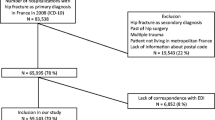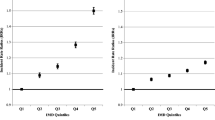Abstract
Lifestyle factors such as diet and physical activity vary in different social and income groups, and are known to be important influences on the incidence of osteoporotic fractures. Financial and social pressures are a common concern for older people. We set out to study the effect of socioeconomic deprivation on the incidence of fracture in older people and to compare the findings with those for younger groups. The All Wales Injury Surveillance System (AWISS) is a computerized system that collects injury data from most A&E departments throughout Wales. In this population-based study of 1.8 million people living in the 445 electoral tracts covered by AWISS in south, west, and northeastern Wales, we identified all 60,106 residents who presented with a fracture in 1999 and 2000. We linked details of their fracture with published Townsend deprivation scores for the electoral tract in which they were living and calculated fracture rates by fifths of deprivation. We observed the expected pattern of increasing fracture incidence in older age groups. Fracture incidence was significantly higher in electoral wards with poorer Townsend scores, resulting from a marked effect of socioeconomic deprivation on fracture incidence among younger adults with a rate ratio of 1.64 (95% CI, 1.57 to 1.72). This effect diminished with age, and was not observed in older age groups. At ages 85 and over the rate ratio was 0.94 (95% CI, 0.87 to 1.01). Socioeconomic factors clearly play a part in the causation of fracture in younger adults. Lifestyle influences are important in older age groups, but socioeconomic deprivation does not appear to be a risk factor for the development of osteoporotic fractures in elderly people.



Similar content being viewed by others
References
Towner E, Dowswell T, Errington G, Burkes M, Towner J (2002) Injuries in children aged 0–14 years and inequalities. Health Development Agency, London
del Rio Barquero L, Romera Baures M, Pavia Segura J, Setoain Quinquer J, Serra Majem L, Garces Ruiz P, Lafuente Navarro C, Domenech Torne FM (1992) Bone mineral density in two different socio-economic population groups. Bone Miner 18(2):159–168
Varenna M. Binelli L, Zucchi F, Ghiringhelli D, Gallazzi M, Sinigaglia L (1999) Prevalence of osteoporosis by educational level in a cohort of postmenopausal women. Osteoporos Int 9(3):236–241
Elffors I, Allander E, Kanis JA, Gullberg B, Johnell O, Dequeker J, Dilsen G, Gennari C, Lopes Vaz AA, Lyritis G (1994) The variable incidence of hip fracture in southern Europe: the MEDOS Study. Osteoporos Int 4(5):253–263
Kanis JA, McCloskey EV (1992) Epidemiology of osteoporosis. Bone 13:S1–S10
Kanis JA (1993) The incidence of hip fracture in Europe. Osteoporos Int 3[Suppl 1]:10–15
Cooper C (1993) Epidemiology and public health impact of osteoporosis: Bailliere’s clinical rheumatology. 7(3):459–477
Muscat Baron Y, Brincat M, Galea R, Muscat Baron A (1994) The epidemiology of osteoporotic fractures in a Mediterranean country. Calcif Tissue Int 54:365–369
Sernbo I, Johnell O, Andersson T (1988) Differences in the incidence of hip fracture: comparison of an urban and a rural population in southern Sweden. Acta Orthop Scand 59(4):382–385
Jonsson B, Gardsell P, Johnell O, Sernbo I, Gullberg B (1993) Life-style and different fracture prevalence: a cross-sectional comparative population-based study. Calcif Tissue Int 52(6):425–433
Lyons RA, Jones S, Kemp A, Sibert J, Shepherd J, Richmond P, Bartlett C, Palmer SR (2002) The development and use of a low cost injury surveillance system: the All Wales Injury Surveillance System (AWISS). Inj Prev 8(1):83–86
Lyons RA, Delahunty AM, Kraus D, Heaven M, McCabe M, Allen H, Nash P (1999) Children’s fractures: a population based study. Inj Prev 5:129–132
Johansen A, Evans RJ, Bartlett C, Stone MD (1998) Fractures in the elderly: factors that influence the need for admission to hospital following presentation to the A&E department. Injury 29:779–784
Brennan J, Johansen A, Butler J, Stone M, Richmond P, Jones S, Lyons RA (2003) Place of residence and risk of fracture in older people: a population based study of over 65 year olds in Cardiff. Osteoporos Int 14:515–519
Department of Health and Social Services (1980) Inequalities in health: report of a research working groups (The Black Report). DHSS, London
PAT18 (2000) Working paper: measuring deprivation—a review of indices in common use. http://www.cabinet-office.gov.uk/sED/2000/pat18/Depindices.htm
Lyons RA, Jones SJ, Deacon T, Heaven M (2003) Socio-economic variation in injury in children and older people: population based study. Inj Prev 9:33–37
Johansen A, Evans R, Stone MD, Richmond P, Lo SV, Woodhouse KW (1997) The incidence of fracture in the United Kingdom: a study based on the population of Cardiff. Injury 28:655–660
Johansen A, Harding K, Evans R, Stone M (1999) Trauma in elderly people: what proportion of fractures are a consequence of bone fragility? Arch Gerontol Geriatr 29:215–221
Lyons RA, Sellstrom E, Delahunty AM, Loeb M, Varilo S (2000) Incidence and cause of fractures in European districts. Arch Dis Child 82:452–455
Acknowledgements
The authors would like to thank the owners and residents of the 30 care homes who collaborated with this research and the Wellcome Trust, which funded the care home aspect of the study (grant 058075).
Author information
Authors and Affiliations
Corresponding author
Rights and permissions
About this article
Cite this article
Jones, S., Johansen, A., Brennan, J. et al. The effect of socioeconomic deprivation on fracture incidence in the United Kingdom. Osteoporos Int 15, 520–524 (2004). https://doi.org/10.1007/s00198-003-1564-3
Received:
Accepted:
Published:
Issue Date:
DOI: https://doi.org/10.1007/s00198-003-1564-3




